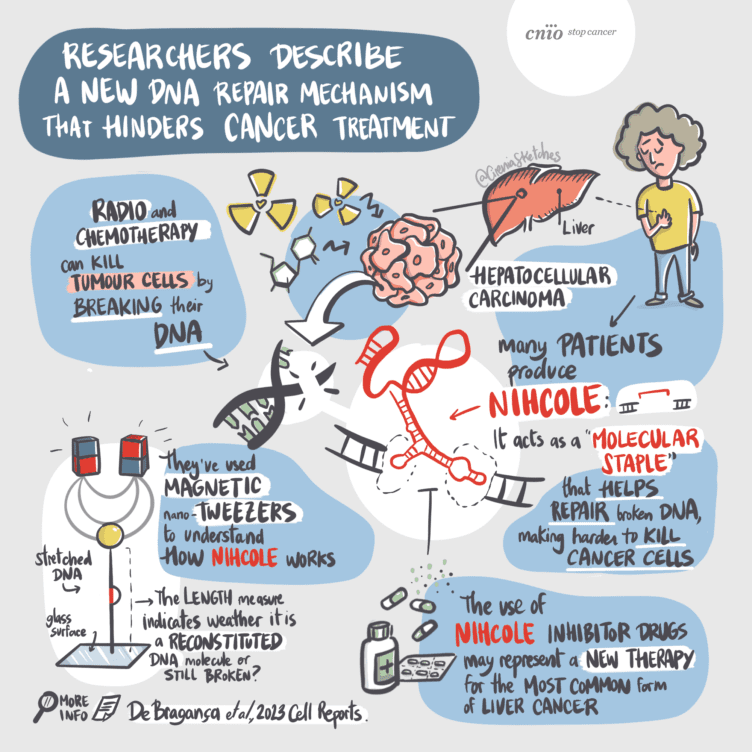Due to the continuous cellular activity, malfunctions frequently occur, making error-correcting systems crucial for cells. However, it serves the cancer cells’ best interests to cause errors when it comes to destroying them. By rupturing the DNA of the cells, radiation treatment and chemotherapy can result in cellular abnormalities.
 One of the causes of aggressive liver cancer discovered: a ‘molecular staple’ that helps repair broken DNA. Image Credit: CireniaSketches. CNIO
One of the causes of aggressive liver cancer discovered: a ‘molecular staple’ that helps repair broken DNA. Image Credit: CireniaSketches. CNIO
However, certain tumor cells have a highly effective DNA repair system that enables them to avoid the effects of cancer treatments.
A molecular staple that has been first seen in action using a new nanotechnology technique has been revealed in action by researchers Óscar Llorca of the Spanish National Cancer Research Center (CNIO), Fernando Moreno-Herrero of the CNB, and Puri Fortes of the CIMA-University of Navarra in a study published in Cell Reports. It described the workings of one of these extraordinary repair systems.
In liver cancer with the worst prognosis
An RNA molecule called NIHCOLE, which is primarily found in the most aggressive tumors and is associated with a poor prognosis, is produced by about half of the patients with hepatocellular carcinoma, the most prevalent type of liver cancer, according to research conducted a few years ago by a team led by Puri Fortes.
According to Fortes, Llorca, and Moreno-Herrero’s findings, NIHCOLE is highly effective in assisting with the repair of damaged DNA, which is why radiation is less successful in tumors where it is present. Radiation treatment for cancer makes cancer cells more susceptible to death by removing NIHCOLE.
However, it remained unknown how NIHCOLE supports the repair of DNA breaks at the molecular level. According to the study that was published in Cell Reports, NIHCOLE creates a bridge that connects the damaged DNA segments.
Llorca and Moreno-Herrero stated, “NIHCOLE interacts simultaneously with proteins that recognize the two ends of a fragmented DNA, as if stapling them together.”
Understanding this process might aid in the development of ways to treat liver tumors with the worst prognosis.
The researchers added, “The use of NIHCOLE inhibitor drugs may represent a new therapy for the most common form of liver cancer.”
Magnetic nano-tweezers for stretching DNA
Fernando Moreno-Herrero’s team employed magnetic tweezers, a nanotechnology method that makes it possible to examine the physical characteristics of individual molecules, to learn how NIHCOLE functions.
To identify the junction between the two fragmented ends, researchers have created a DNA molecule that resembles broken DNA. They start by placing a millimeter-sized magnetic bead on one end of the DNA and then tug on that end with magnetic nano-tweezers.
The length of the stretched DNA reveals whether the DNA molecule is still broken or has been reassembled, with the broken ends of the DNA linked together.
These data demonstrate, in the opinion of the authors of the Cell Reports paper, that NIHCOLE, “confers advantages on tumor cells by helping them to repair DNA breaks, thereby sustaining the malignant proliferation of cancer cells despite the accumulation of DNA damage resulting from the stress of cell division itself.”
“Junk DNA” that is no longer junk
NIHCOLE is an RNA molecule, not a protein produced by a gene. When the human genome was sequenced two decades ago, it was a component of what researchers called junk DNA. They were under the impression that this DNA was worthless at the moment.
One of the central dogmas of biology is that the information contained in each gene, in DNA, is translated into proteins. So, scientists were stunned when they discovered that only 2% of our DNA contained genes; what was the rest of our genome for? It is unthinkable that 98% of the genome is junk, useless DNA. In the last decade it has been shown that part of this dark genome produces very long RNA molecules, some of which have a prevalent function in cancer.”
Óscar Llorca, Researcher, Biological Research Centre, Spanish National Cancer Research Center
One of these lengthy RNA molecules is NIHCOLE, whose existence and function have just lately been fully understood to the point where scientists are still in awe. Another unexpected finding is that only a small portion of NIHCOLE is needed for it to function as a molecular staple.
The study authors concluded, “This would allow the development of drugs that block or distort this structure, and thus improve the efficacy of radiotherapy or chemotherapy in cancer patients.”
Source:
Journal reference:
De Bragança, S., et al. (2023). APLF and long non-coding RNA NIHCOLE promote stable DNA synapsis in non-homologous end joining. Cell Reports. doi.org/10.1016/j.celrep.2022.111917